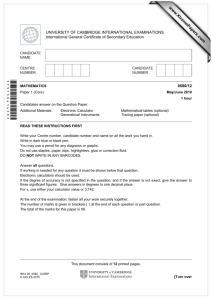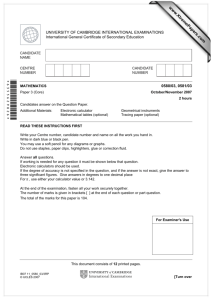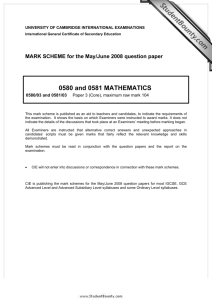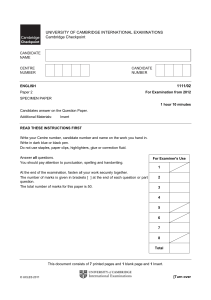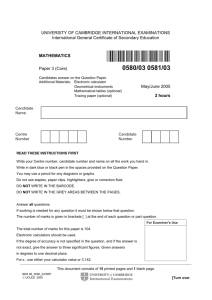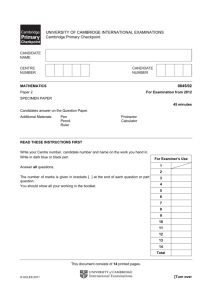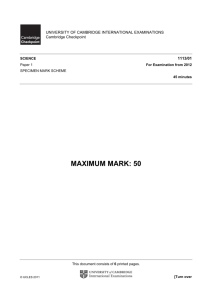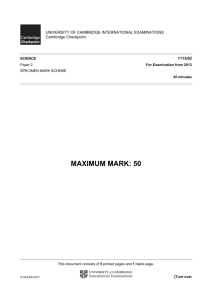2008 Paper 3 W - British Academy Wiki
advertisement
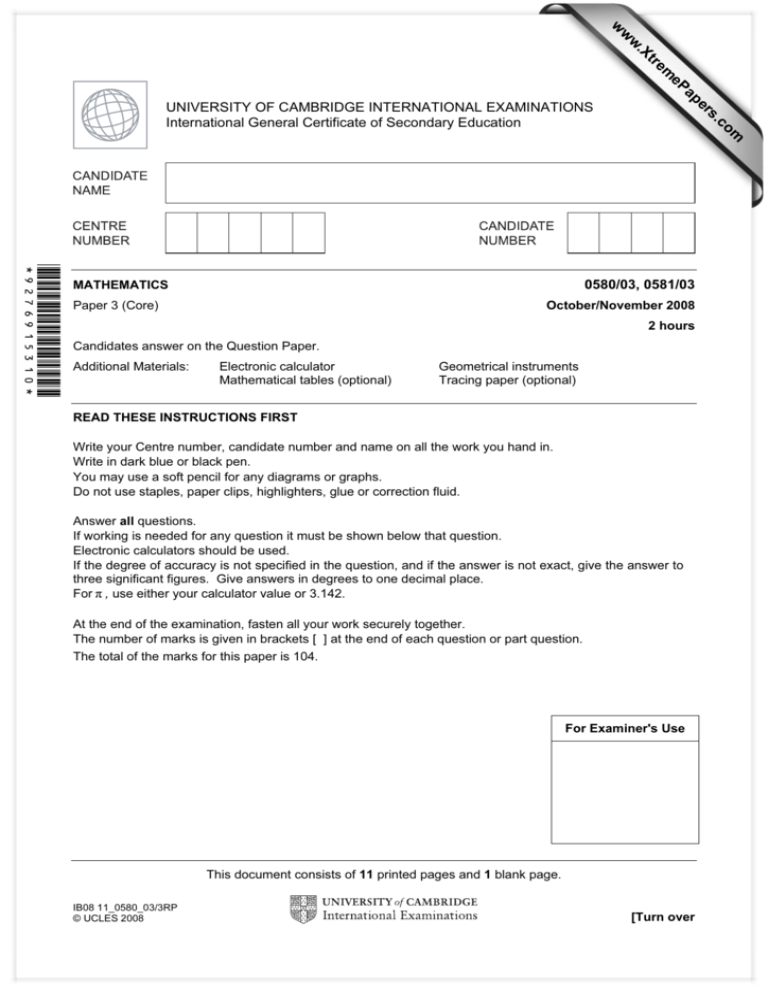
w w ap eP m e tr .X w om .c s er UNIVERSITY OF CAMBRIDGE INTERNATIONAL EXAMINATIONS International General Certificate of Secondary Education *9276915310* 0580/03, 0581/03 MATHEMATICS October/November 2008 Paper 3 (Core) 2 hours Candidates answer on the Question Paper. Additional Materials: Electronic calculator Mathematical tables (optional) Geometrical instruments Tracing paper (optional) READ THESE INSTRUCTIONS FIRST Write your Centre number, candidate number and name on all the work you hand in. Write in dark blue or black pen. You may use a soft pencil for any diagrams or graphs. Do not use staples, paper clips, highlighters, glue or correction fluid. Answer all questions. If working is needed for any question it must be shown below that question. Electronic calculators should be used. If the degree of accuracy is not specified in the question, and if the answer is not exact, give the answer to three significant figures. Give answers in degrees to one decimal place. For π , use either your calculator value or 3.142. At the end of the examination, fasten all your work securely together. The number of marks is given in brackets [ ] at the end of each question or part question. The total of the marks for this paper is 104. For Examiner's Use This document consists of 11 printed pages and 1 blank page. IB08 11_0580_03/3RP © UCLES 2008 [Turn over 2 1 Aida, Bernado and Cristiano need $30 000 to start a business. (a) (i) They borrow 2 5 For Examiner's Use of this amount. Show that they still need $18 000. Answer (a)(i) [1] (ii) They provide the $18 000 themselves in the ratio Aida : Bernado : Christiano = 5 : 4 : 3. Calculate the amount each of them provides. Answer(a)(ii)Aida $ Bernado $ Cristiano $ [3] (b) (i) Office equipment costs 35 % of the $30 000. Calculate the cost of the equipment. Answer(b)(i)$ [2] (ii) Office expenses cost another $6500. Write this as a fraction of $30 000. Give your answer in its lowest terms. Answer(b)(ii) [2] (iii) How much remains of the $30 000 now? Answer(b)(iii)$ [1] (c) They invest $12 500. After one year this has increased to $15 500. Calculate this percentage increase. Answer(c) © UCLES 2008 0580/03/O/N/08 % [3] 3 2 For Examiner's Use F NOT TO SCALE A B 12 m 55m 25° 18° E D C ABCD represents a building with a vertical flagpole, AF, on the roof. The points E, D and C are on level ground. EA = 55 metres. The angle of elevation of A from E is 18° and the angle of elevation of F from E is 25°. (a) Calculate (i) ED, Answer(a)(i) m [2] Answer(a)(ii) m [2] Answer(a)(iii) m [2] (ii) FD, (iii) DA. (b) Show that AF = 7.4 metres, correct to 1 decimal place. Answer(b) [1] (c) The width, AB, of the building is 12 metres. The top of the flagpole is attached to the point B by a rope. Calculate (i) the length of the rope, FB, Answer(c)(i) m [2] (ii) the angle of elevation of F from B. Answer(c)(ii) © UCLES 2008 0580/03/O/N/08 [2] [Turn over 4 3 The table below shows the average daily sunshine, s, and the total monthly rainfall, r, for a city during one year. Month Jan Feb Mar Apr May June July Aug Sep Oct Nov Dec s (hours) 6 7 7 9 10 12 12 12 9 8 6 5 r (mm) 70 52 72 41 20 6 1 4 16 52 65 67 (a) For s, find (i) the mode Answer(a)(i) hours [1] Answer(a)(ii) hours [1] Answer(a)(iii) hours [2] (ii) the range, (iii) the median. (b) On the grid below, plot the 10 points for March to December to complete the scatter diagram. r 70 60 50 Total Monthly 40 Rainfall (mm) 30 20 10 0 5 6 7 8 9 10 11 12 s Average Daily Sunshine (hours) [3] © UCLES 2008 0580/03/O/N/08 For Examiner's Use 5 (c) (i) Calculate the mean of s. For Examiner's Use Answer(c)(i) hours [2] (ii) The mean of r is 38.8 millimetres. On the grid, plot the point representing these means. Label this point M. (d) (i) Draw a line of best fit on the grid. [1] [1] (ii) What type of correlation does your scatter diagram show? Answer(d)(ii) [1] 4 G D C NOT TO SCALE B 68° E A EG is a diameter of the circle through E,C and G. The tangent AEB is parallel to CD and angle AEC = 68°. Calculate the size of the following angles and give a reason for each answer. (a) Angle CEG = because [2] (b) Angle ECG = because [2] (c) Angle CGE = because [2] (d) Angle ECD = because [2] © UCLES 2008 0580/03/O/N/08 [Turn over 6 5 Aminata and her brother live 18 kilometres from a shopping centre. For Examiner's Use (a) Aminata leaves home at 09 00 and runs 3 kilometres to a bus stop. She arrives there at 09 30. Write down her average speed, in kilometres per hour. Answer(a) km / h [1] (b) She waits 15 minutes for the bus. The bus travels the remaining 15 kilometres to the shopping centre at an average speed of 20 km / h. (i) At what time does she arrive at the shopping centre? Answer(b)(i) [2] (ii) On the grid below, complete the travel graph showing her journey to the shopping centre. 20 Shopping Centre 18 16 14 12 Distance from home (km) 10 8 6 4 2 Home 0 09 00 10 00 11 00 12 00 13 00 Time [2] © UCLES 2008 0580/03/O/N/08 7 (c) Her brother leaves home at 11 15. He travels to the shopping centre by car at an average speed of 54 km / h. For Examiner's Use (i) Work out how long, in minutes, he takes to travel to the shopping centre. Answer(c)(i) (ii) Show his journey on the grid. minutes [1] [1] (d) Aminata and her brother leave the shopping centre at 12 00. They travel home by car and arrive at 12 45. (i) Show their journey home on the grid. [1] (ii) Calculate the average speed of their journey home. Answer(d)(ii) 6 km / h [2] 2y = 75 − 7x (a) (i) Find y when x = 7. Answer(a)(i) y = [2] Answer(a)(ii) x = [2] (ii) Find x when y = 6. (b) Make x the subject of the equation 2y = 75 − 7x. Answer(b) x = [2] (c) Solve these simultaneous equations. 4x − y = 45 7x + 2y = 75 Answer(c) x = y= © UCLES 2008 0580/03/O/N/08 [3] [Turn over 8 7 (a) Complete the table of values for the equation y = x2 + x − 3. x −4 y 9 −3 −2 −1 −1 −3 0 1 −1 For Examiner's Use 2 3 9 [3] (b) On the grid, draw the graph of y = x2 + x − 3. y 10 9 8 7 6 5 4 3 2 1 –4 –3 –2 –1 0 1 2 x 3 –1 –2 –3 –4 [4] (c) Write down the coordinates of the lowest point of the curve. Answer(c) ( (d) (i) Draw the line of symmetry of the graph. , ) [2] [1] (ii) Write down the equation of the line of symmetry. Answer(d)(ii) © UCLES 2008 0580/03/O/N/08 [1] 9 8 For Examiner's Use y 6 5 4 3 C 2 1 B –6 –5 –4 –3 –2 –1 0 –1 1 2 3 4 5 6 x –2 A –3 –4 –5 Triangle ABC is drawn on the grid. (a) (i) Write down the coordinates of A. Answer(a)(i) ( , ) [1] (ii) Write AB and BC as column vectors. Answer(a)(ii) AB = BC = [2] 4 (b) Translate triangle ABC by the vector _ . Label the image T. 3 [2] (c) AP = 2 AB and AQ = 2 AC . (i) Plot the points P and Q on the grid. [2] (ii) Describe fully the single transformation which maps triangle ABC onto triangle APQ. Answer(c)(ii) [3] (d) Rotate triangle ABC through 180° about the midpoint of the side AB. Label the image R. © UCLES 2008 0580/03/O/N/08 [2] [Turn over 10 9 The quadrilateral ABCD is a scale drawing of a park. Angle ABC = 90° and 1 centimetre represents 10 metres. For Examiner's Use D A B C (a) Write down (i) the actual length, in metres, of the side CD, Answer(a)(i) m [1] (ii) the size of angle BAD. Answer(a)(ii) [1] (b) Two straight paths cross the park. One path is the same distance from AB as from BC. The other path is the same distance from A as from D. (i) Using a straight edge and compasses only, construct the lines which show each path. [4] (ii) Tennis courts in the park are situated in a region closer to AB than to BC and closer to A than to D. Label this region T. [1] (c) Keith cycles past the park, so that he is always 30 metres outside the boundary ABC. Construct the locus of points which shows this part of his route. © UCLES 2008 0580/03/O/N/08 [2] 11 10 The first three diagrams in a sequence are shown below. Each diagram has one more trapezium added on the right. Diagram 1 For Examiner's Use Diagram 2 Diagram 3 (a) Complete the table which shows the number of lines and dots in each diagram. Diagram 1 2 Number of lines 4 7 Number of dots 4 6 3 4 [2] (b) Find the number of lines and dots in Diagram 10. Answer(b) lines and dots [2] (c) For Diagram n, write down in terms of n, the number of (i) lines, Answer(c)(i) [2] Answer(c)(ii) [2] (ii) dots. (d) Find the difference, in terms of n, between your answers to parts (c)(i) and (c)(ii). Simplify your answer. Answer(d) © UCLES 2008 0580/03/O/N/08 [2] 12 BLANK PAGE Permission to reproduce items where third-party owned material protected by copyright is included has been sought and cleared where possible. Every reasonable effort has been made by the publisher (UCLES) to trace copyright holders, but if any items requiring clearance have unwittingly been included, the publisher will be pleased to make amends at the earliest possible opportunity. University of Cambridge International Examinations is part of the Cambridge Assessment Group. Cambridge Assessment is the brand name of University of Cambridge Local Examinations Syndicate (UCLES), which is itself a department of the University of Cambridge. 0580/03/O/N/08


